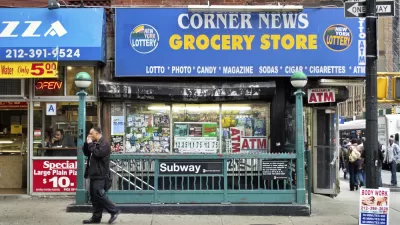The "food deserts" problem is receiving heightened attention following the release of the USDA's locator map. But this analysis relies on the suspect premise that suburban supermarkets are superior to small, walkable urban foodsellers.
Angie Schmitt at Streetsblog argues that all the hullabaloo over food deserts assumes that the cavernous suburban grocery store is the ultimate model of food distribution:
"While there is certainly a class of convenience store that lacks healthy food options, many analyses have completely ignored the presence of small, family-owned food markets and their important role in feeding urban populations."
Schmitt points to the USDA's own admission that their definition of what is a valid market is biased:
"Mary Reardon, a spokesperson for USDA said, "We define supermarkets and large grocery stores as food stores with at least $2 million in [annual] sales that contain all the major food departments found in a traditional supermarket."
"We do not address smaller outlets that have fresh food," she said."
Thanks to Angie Schmitt
FULL STORY: In Defense of the Corner Market

Alabama: Trump Terminates Settlements for Black Communities Harmed By Raw Sewage
Trump deemed the landmark civil rights agreement “illegal DEI and environmental justice policy.”

Planetizen Federal Action Tracker
A weekly monitor of how Trump’s orders and actions are impacting planners and planning in America.

The 120 Year Old Tiny Home Villages That Sheltered San Francisco’s Earthquake Refugees
More than a century ago, San Francisco mobilized to house thousands of residents displaced by the 1906 earthquake. Could their strategy offer a model for the present?

Indy Neighborhood Group Builds Temporary Multi-Use Path
Community members, aided in part by funding from the city, repurposed a vehicle lane to create a protected bike and pedestrian path for the summer season.

Congestion Pricing Drops Holland Tunnel Delays by 65 Percent
New York City’s contentious tolling program has yielded improved traffic and roughly $100 million in revenue for the MTA.

In Both Crashes and Crime, Public Transportation is Far Safer than Driving
Contrary to popular assumptions, public transportation has far lower crash and crime rates than automobile travel. For safer communities, improve and encourage transit travel.
Urban Design for Planners 1: Software Tools
This six-course series explores essential urban design concepts using open source software and equips planners with the tools they need to participate fully in the urban design process.
Planning for Universal Design
Learn the tools for implementing Universal Design in planning regulations.
Clanton & Associates, Inc.
Jessamine County Fiscal Court
Institute for Housing and Urban Development Studies (IHS)
City of Grandview
Harvard GSD Executive Education
Toledo-Lucas County Plan Commissions
Salt Lake City
NYU Wagner Graduate School of Public Service





























